Corn Snake Morphs Facts
Know all about Corn Snake Morphs like its size, lifespan, Corn snake bite, Corn Snake Diet, different beautiful corn snake morphs. Also find 11 incredible corn snake’s facts below in this article.
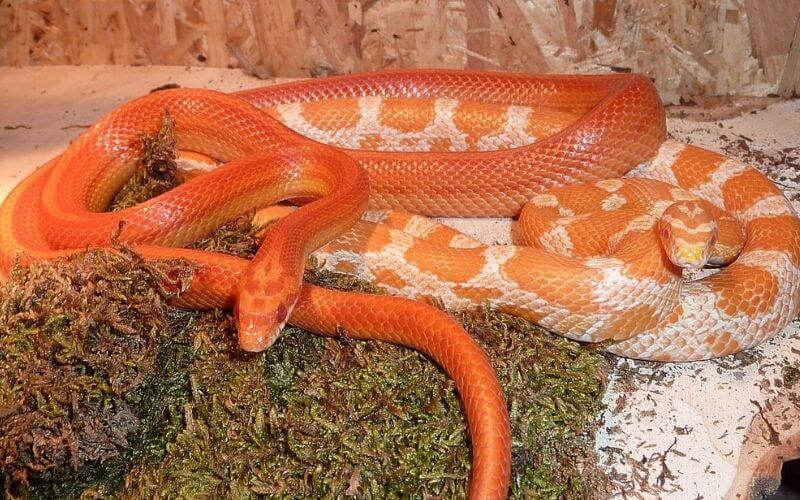
General Information of Corn Snake
Scientific Name:Pantherophis guttatus
Average Size: Length: 30 to 48 in.; record is 72 in.
Diet: Carnivore
Range:North America
Habitat :Dry Forest, Urban Areas, Woodlands
Corn Snake Size & Physical Appearance
This snake is named for the pattern of their belly scales that resembles maize.
Corn snakes are approximately 60 to 180 centimeters long. Males often grow larger than females.
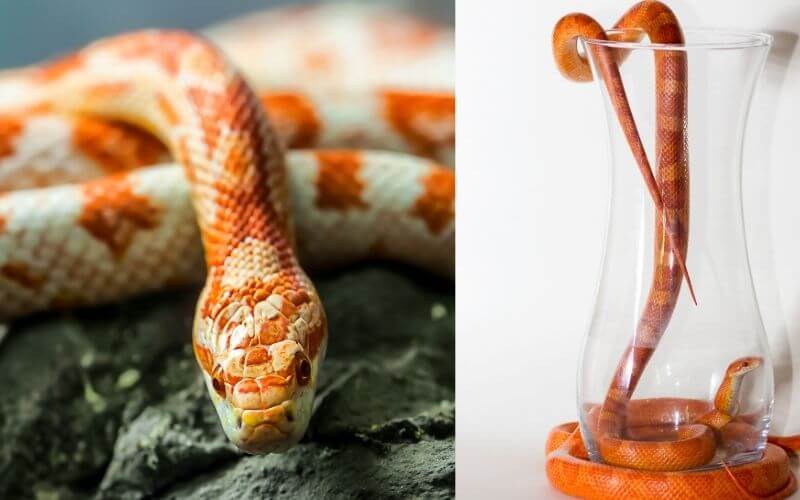
Corn Snake Lifespan
Corn snakes live up to 23 years in captivity; most wild corn snakes probably do not survive adulthood. In the wild, they usually live around six to eight years.
The oldest corn snake in captivity was 32 years and three months.
Corn Snake Habitats & Habits
Wild Corn snakes inhabit wooded groves, rocky hillsides, overgrown fields, forest openings, trees, rocky open areas, tropical hammocks, barns, and abandoned buildings and farms.
They can be found very commonly in the pine-wiregrass Flatwoods and sandhills of the central and southern Coastal Plain, and least common in the mountainous areas of western North Carolina.
Corn snakes are one of the most popular types of snakes to make your pets. They are calm and are easy to take care of. Captive corn snakes tolerate being handled by their owners.
Does a corn snake bite?
Do corn snake bites hurt?
Corn snakes are non-venomous and also they do not have sharp fangs. So, if a corn snake bites you it would be a minor injury just like a cat scratch.
Still, if you have been bitten by corn snakes, thoroughly clean the affected area with antiseptic soap to prevent infection and consult your doctor if your skin has been broken. What to do if your pet snake bites you.
Corn Snake Diet
Corn Snake Morphs
What is Morph?
Morphs mean the snake has morphed to look different from the original or traditional due to genetic mutation, but the snake remains the same breed. A morph is entirely different than a Genetic Defect where it generally affects color rather than physical appearances.
There are different categories of Corn Snake Morphs
Color Morph:
Color morphs are corn snakes with unusual colorings. These morphs are common in captivity.
These are the different types of color morph:
- Normal
- Miami
- Okeetee
- Candy-cane
- Reverse Okeetee
- Fluorescent Orange
- Sunglow
- Blood Red
- Crimson
- Anerythristic
- Charcoal
- Caramel
- Lavender
- Cinder
- Kastanie
- Hypomelanistic
- Ultra
- Ultramel
- Dilute
- Sunkissed
- Lava
Pattern Morph:
Pattern morphs means the corn snakes pattern has been altered without changing the color.
- Motley
- Striped
- Diffused
- Sunkissed
- Aztec, Zigzag, and Banded
Compound Morph:
There are many thousands of possible compound morphs. Here are some of the most popular compound morphs of corn snake.
- Snow
- Blizzard
- Ghost
- Phantom
- Pewter
- Butter
- Amber
- Plasma
- Opal
- Granite Fire
Hybrid Morph:
Hybrids between corn snakes and any other snake is very common in captivity but rarely occurs in the wild. Few names of them are given below:
- Jungle
- Tri-color Jungle
- Creamsicle
- Turbo
- Brook Korn
Some Popular Corn Snake Morphs
Albino Corn Snake:
The albino corn snake is also referred to as the “amelanistic” or “red albino.” Albino corn snake looks amazingly beautiful with its white and red scales, bright red eyes, and corn kernel-patterned stomach. They have no black pigment. Like all corn snakes, their scales are lightly keeled.
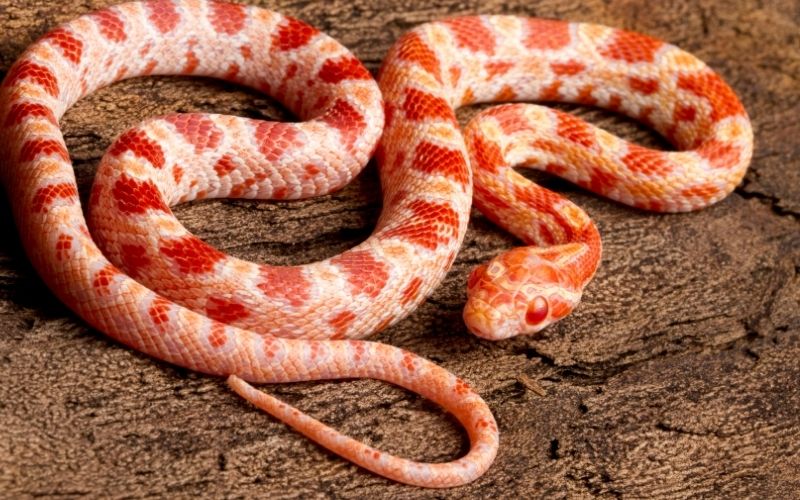
Albino corn snakes make great pets because of their lifespan, calm temperament, and easy-to-care-for nature.
This snake’s size is the same as a normal corn snake, between three to five feet.
Albino corn snakes are constrictors, and their diet consists of mice and other rodents, chicks, and lizards. In captivity, the lifespan of most of the Albino Corn Snakes is 24 years old. Sometimes, these snakes can live to be even older.
If you want to know more about Albino Corn Snake, you can visit this wonderful site.
Lavender Corn Snake:
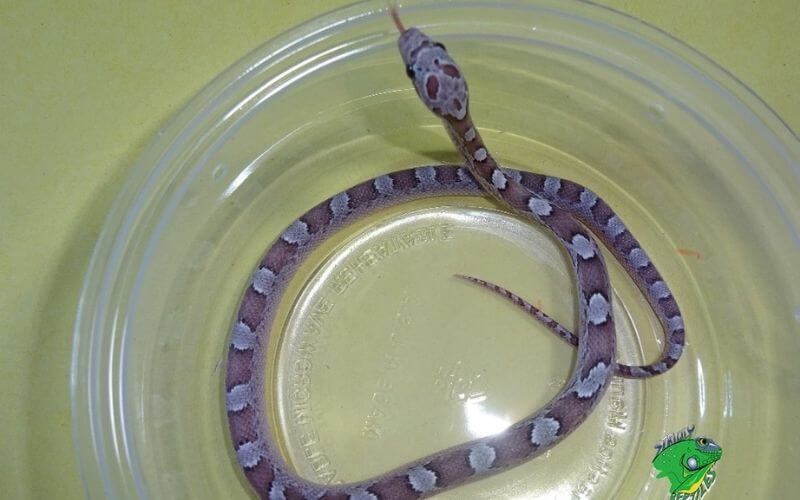
Lavender is a base morph that was first produced in the 1980s. The Lavender corn snake is one of the most popular corn snake morphs. Light pink-grey background color with Dark purple-grey markings & striking, Reddish eyes makes it so beautiful. Lavender corn snake morphs are different color palettes of the same snake.
Did you know? The oldest corn snake in captivity lived for 32 years and three months.
Some other morphs can be created with the lavender gene:
- Hypo Lavender Corn Snake = hypomelanistic + lavender
- Orchid Corn Snake = lavender + sunkissed
- Lavender Motley Corn Snake = lavender + motley
- Plasma Corn Snake = diffused + lavender
- Moonstone Corn Snake (Anery Lavender) = anerythristic + lavender
- Amaretto Corn Snake (Amber Lavender) = caramel + hypomelanistic + lavender
- Lavender Tessera Corn Snake = lavender + tessera
- Opal Corn Snake = amelanistic (albino) + lavender
- Lavender Stripe Corn Snake = lavender + stripe
- Lavender Ghost Corn Snake = anerythristic + hypomelanistic + lavender
Okeetee Corn Snake
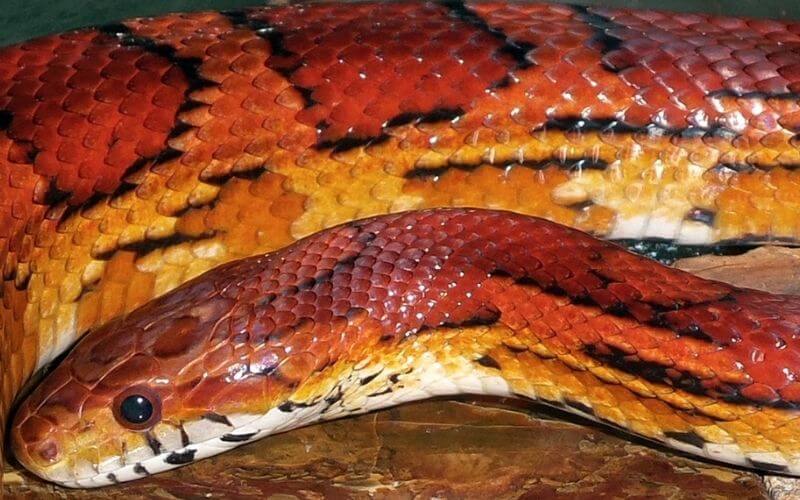
Okeetee corn snakes have deep red dorsal saddle marks surrounded by black borders on a bright orange background color. Okeetee corn snake’s length is around 2 to 5 feet. Its weight will reach between 500 and 750g at 5-feet long.
Few Okeetee Corn Snake Morphs name are:
- Abbotts Okeetee
- Extreme Okeetee
- Reverse Okeetee
- Kathy Love Okeetee
- Okeetee Color Lines
- Buckskin Okeetee
Snow Corn Snake
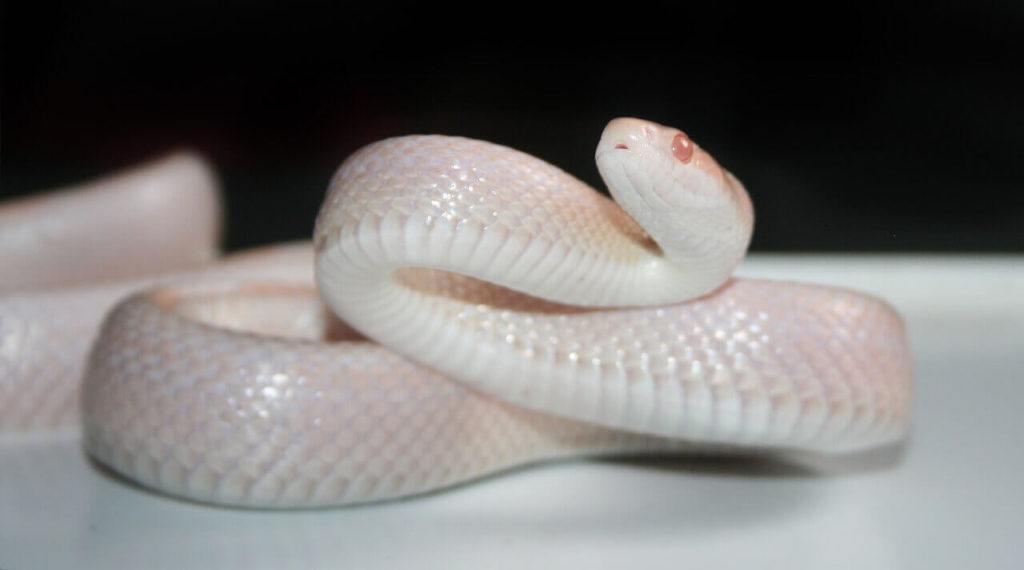
Snow Corn Snakes are a combination of the Amelanistic and Anerythristic (Anery A) genes. These snakes are one of the most beautiful of the corn snakes.
As hatchlings, most snow corn snakes look similar. As they mature, their colors vary and include shades of yellow, pink, green, and white.
Palmetto Corn Snake
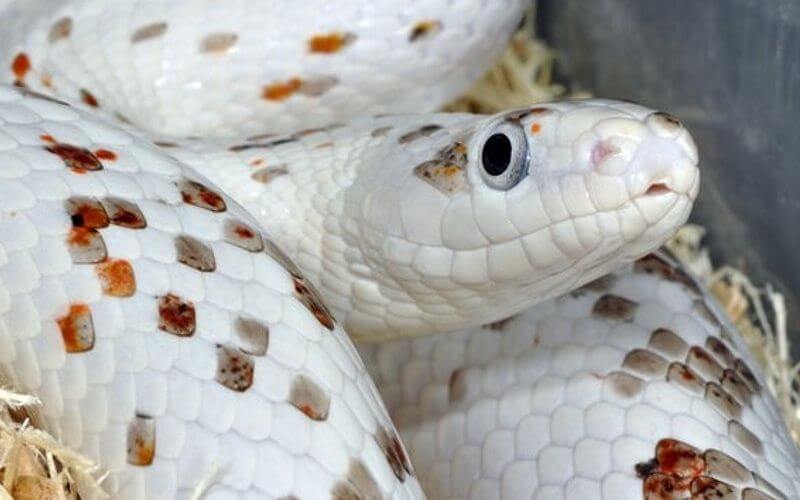
Palmetto is one of the most beautiful and unique corn snakes. The Palmetto is the official nickname for South Carolina, referring to the state tree, the Sabal Palmetto, Inodes palmetto.
This snake is mostly white, with random colored scales all over its body. It has black pupils and dirty white or blue iris.
Black Corn Snake
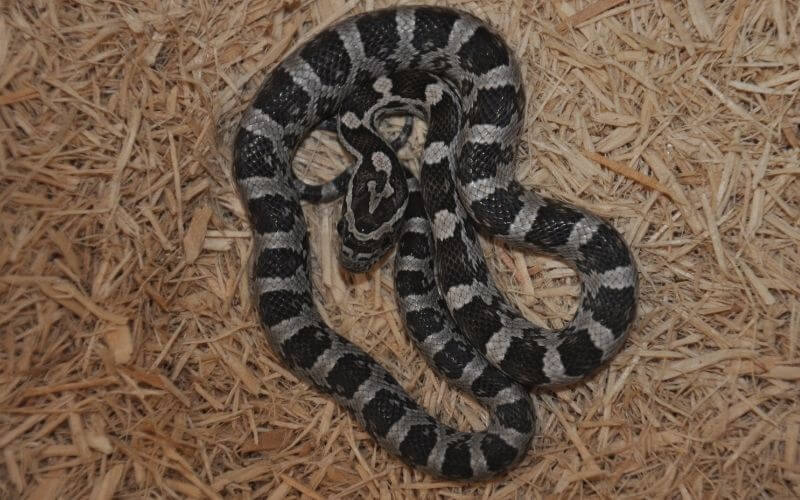
Ghost Corn Snake
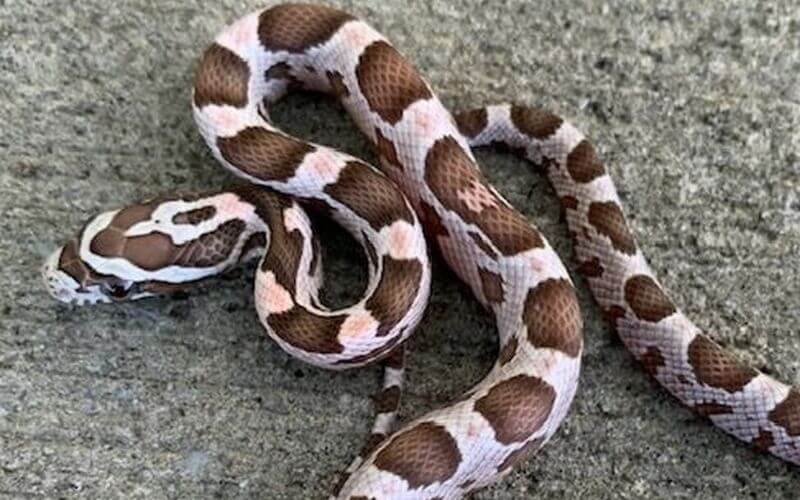
This corn snake is the combination of the Anerythristic (Anery A) and Hypomelanistic genes. Their scale colors can be white, grey, brown, and black.
Red Corn Snake
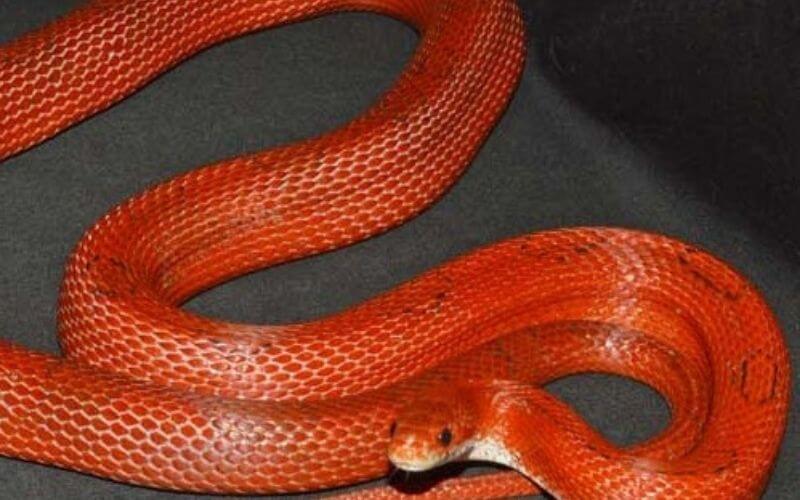
This snake is characterized by the orange to the brown or gray colored background with reddish to orange blotches with black borders.
The size of an adult Red Cornsnake is approximately 3 feet, although some may reach 4 feet in total length.
Amazing Facts About Corn Snake
FACT 1. A corn snake is sometimes called a red rat snake. This snake was first described by famous English naturalist Mark Catesby in the late 1700s in North Carolina.
FACT 2. Corn snakes are not venomous, but they look similar to the venomous snake known as the copperhead and are often killed because of these similarities in appearance.
FACT 3. Corn snakes are among the most popular snakes kept as pets, alongside the garter snake and ball python.
FACT 4. Corn snakes are diurnal animals, which means they are active during the day.
FACT 5. Corn snakes have horrible eyesight. They hunt using thermal pits in their mouths, which act as thermal sensors. The heat pits tell them the direction to hunt.
FACT 6. Corn snakes belong to the group of snakes known as constrictors. These snakes wrap their body around the prey and squeeze it until it dies.
FACT 7. Corn snakes are not only named because of where they live but also because the scale pattern on their bellies looks like kernels.
FACT 8. Female lays 10 to 30 eggs in the nest made of leaves or rotten wood. Eggs that don’t hatch are called slugs.
FACT 9. The record for the oldest corn snake in captivity was 32 years and three months.
FACT 10. According to the Florida Museum of Natural History, the longest corn snake was 72 inches (1.8 meters).
FACT 11. Corn snakes are useful to people by keeping the number of rodents under control.
Below are some reference sites name:
wikipedia.org
reptileadvisor.com
ncwildlife.org
zooatlanta.org
nationalzoo.si.edu
